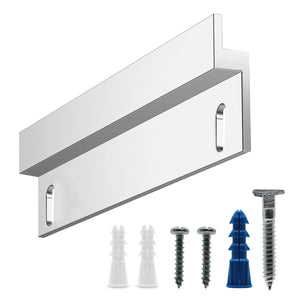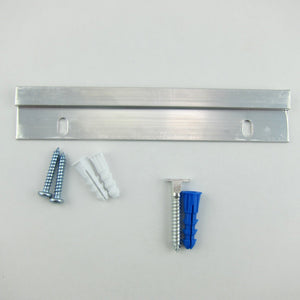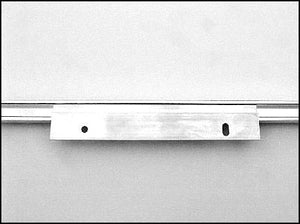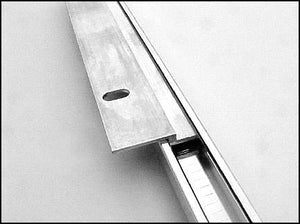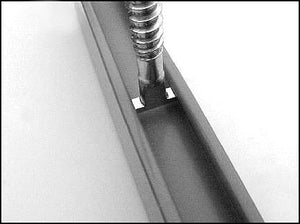About Frame-Lock 6-inch Metal Frame
- 6" Long Light-Duty Cleat Hanger Set for Metal Frame with Security Lock
- For metal frames 6-12 inches wide
- supports up to 50 pounds
- metal cleat works with most Nielsen type metal frames with a 3/8" channel
- made of extruded aluminum 1 1/8" wide by 3/64" thick
- wall standoff is 1/4 inch
Security Metal Cleat Kit includes
- (1) 6-inch cleat - to attach to the wall
- (2) #8 x 1" screws - to attach one cleat to wall
- (2) #8 plastic anchors - if needed to attach cleat to wall
- (1) T-Head security screw - goes in wall and locks frame to wall by attaching to the metal frame channel
- (1) Security Screw Plastic Anchor - to attach security screw to wall
- ****Wrench sold separately****
Descriptions
Frame-Lock Hangers will fit on all currently manufactured metal frames generically designated as #11 Profile moulding. This includes the metal moulding currently made by Nielsen, Clark, Designer, Alumaframe, Global Art, MCS, Decor and most OEM manufacturers. The #11 Profile category (and compatible profiles) constitute probably 95% of the current metal moulding market.
As long as the corner hardware and channel on the backside of your metal frame looks like this and the channel is 3/8" wide, Frame-Lock hardware will fit.
If you are installing older metal-framed pictures, you should be aware that metal frame moulding design has evolved over the years and Frame-Lock T-Head screws and brackets may not fit inside the backchannel of certain older, now obsolete style metal frames (typically pre-1980 manufacture).
There are a small number of these older extrusion profiles still being made, the so-called #186 Profile and #444 Profile. These profiles have a narrower backchannel, measuring about 1/4" wide, compared to the standard 3/8" wide universal channel of the #11 Profile. Frame-Lock Hangers will not fit on #186 or #444 profile metal frame moulding.
Frame-Lock Hangers cannot be used on low-end crimped corner metal frames (also called "back-load" or "back-loaded" frames). Back-loaded metal frames do not have a universal channel at all and look like this at the corners. Click to see a back-loaded metal frame which will not work with this security cleat kit.
Instructions
Any reasonably handy person will have no trouble hanging pictures with Frame-Lock Hangers. The first picture you tackle may take a little time, but once the installation sequence is understood, hanging speed will increase.
A basic instruction sheet is included with each shipment of Frame-Lock Hangers. Or, if you prefer, refer to our complete step-by-step Frame-Lock Hanger installation instructions below.
Don't be intimidated by the number of steps outlined in the Frame-Lock Hanger instructions. The installation process is much more straightforward and intuitive than it might appear from the written description.
- Mark the position on the wall where you want the center of the top of the frame to be. Use a pencil or small piece of tape for this.
- Hold the (6"/12"/18") aluminum bracket horizontally against the wall, with the screw holes at the bottom and the offset end of the bracket facing up and away from the wall. Center the bracket left-to-right on the mark you made on the wall in Step 1, with the top edge of the bracket level at this same mark.
- Punch or mark the position of the hole at the right-hand end of the bracket on the wall.
- Drill a 3/16" dia. hole in the wall at this mark. (A 3/16" dia. hole is usually sufficient for drywall--if the plastic anchor starts to deform when hammering it in during Step 5 below, re-drill the hole using a 1/4" drill bit). If a wall stud is hit, use the screw without the anchor or move the bracket.
- Gently hammer one of the white plastic anchors provided into the hole in the wall until it is just flush with the wall surface. Attach the bracket to the wall using one of the 1" screws provided. Do not tighten this screw down completely yet.
- Carefully level the bracket on the wall using the screw already installed as a pivot point (an inexpensive lightweight "torpedo" level is good for this). Take care to position the bracket on the wall as level as possible.
- Mark for and install a white plastic anchor and screw in a second hole at the left-hand end of the bracket. Depending on the length of the bracket and configuration of the screw holes, be sure at least one of the two screws is in a slotted bracket hole. Tighten down both screws completely but do not over-tighten--they should be snug, but too much force can deform the plastic anchors.
- When the bracket is screwed to the wall at both ends, hang the frame on the bracket so that the offset end of the bracket is seated snugly inside the backchannel of the metal frame's top rail.
- Check the frame for level. If not quite level, small adjustments can be made by removing the frame from the wall, loosening the bracket screw in the slotted hole slightly, shifting the bracket up or down as needed, retightening the screw, and replacing the frame on the bracket.
- If you are using a 12" or 18" bracket, remove the frame from the wall, pencil-mark the position of the bracket on the wall at the bottom edge as a reference, then install the remaining white plastic anchor(s) and screw(s) and replace the frame on the wall.
-
For Frames Using the 6" or 12" Bracket: With the frame hung level on the bracket, lightly pencil-mark the wall at the centerpoint of the frame's bottom rail where the rail's back edge touches the wall.
- Remove the frame from the wall.
- Measure the distance on your metal frame from the outer edge of the frame to the center of the channel (this dimension can vary with different types of metal frames). Transfer this measurement to the wall, making a second pencil mark up from the one(s) made in Step 11 or 12. Erase the bottom mark(s).
- Drill a 5/16" dia. hole at the pencil mark(s) made in Step 14 and gently hammer the blue T-Head plastic anchor(s) provided into the drilled hole(s) until just flush with the wall surface.
- Thread the T-Head screw(s) provided into the plastic anchor(s) until about 3/8" extends out from the wall surface. Start the T-Head screw first by hand and complete using a Security Wrench. Align the head(s) to a final horizontal position.
- Again place the frame on the top bracket. The bottom T-Head screw(s) should now be in position inside the backchannel of the frame's bottom rail.
- From the right-hand side, slide the Security Wrench up underneath the bottom edge of the frame and, without lifting the frame away from the wall, engage and rotate the T-Head screw(s) clockwise one-quarter turn to a vertical position. The frame is now locked to the wall.
